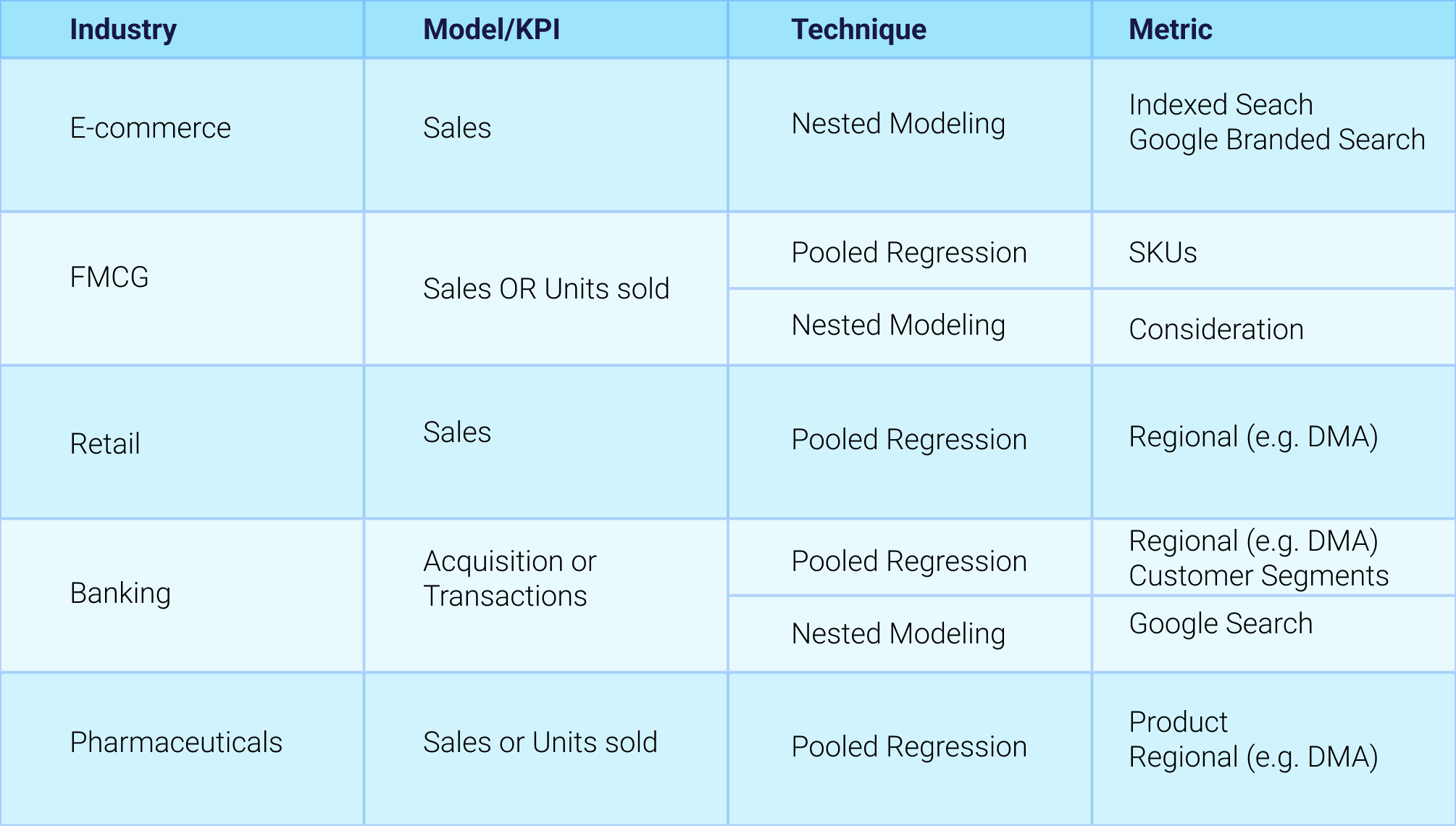Adapting Modern MMM Techniques to Diverse Industry Requirements
Over the years, Marketing Mix Modeling has evolved to be a methodology that caters to different industries.
Despite its beginning in the FMCG industry, it is now widely used by experts, all around the world, from different backgrounds with the sole purpose of answering the age-old question: How does marketing spend influence revenue?
In this article, we explore two modeling techniques – Nested Modeling & Pooled Regression- that have made it easier for analysts to answer that very question. They are two of the most popular and cutting-edge techniques used by analysts in Marketing Mix Modeling projects to answer their industry-specific questions.
Let’s start with the
E-commerce Industry
E-commerce providers are marketplaces that sell their own products or products from other brands on their websites. Besides modeling their sales, these companies are also interested in disentangling any brand awareness impact. To do this, they would usually use nested modeling to build a nested model using Google search index as a proxy.
In one of the cases, we collaborated with a global Marketplace, they wanted to measure the impact of their digital investment on sales. They had multiple products sold on the website and recognized that awareness has an important indirect effect on the sales of their products. To answer their question, we built a nested model for Google Brand Index and were able to disentangle this effect.
When considering candidates for this position, our Director of Marketing Analytics suggests asking these questions:
- What are the key factors and macro-level steps for successful MMM Projects?
- What are the strengths and weaknesses of MMM methodologies and how do they compare against the other marketing effectiveness measurement approaches (MTA, experiments)? Can these approaches be complimentary and how?
- How do you ensure your MMM model combines the science stemming from the mathematical methodologies and the artistic side based on business understanding?
The next example is
The FMCG industry
As mentioned previously, MMM was initially developed for this industry. The FMCG or Fast-Moving Consumer Goods industry includes companies that promote products that sell quickly at a low cost (Milk, snacks, etc.), also known as CPG companies: Consumer Packaged Goods. The stakeholders in these companies are usually interested to know how their marketing investments are influencing the number of product units sold, or sales. Of Particular interest is the Halo and Brand effects.
Since FMCG companies are usually brands that offer more than one variant of their products, they are usually interested in measuring their sales on the SKU (stock-keeping unit) level. This calls for the use of Pooled Regression. Using this technique, they can figure out how their marketing mix is influencing sales at the SKU level and at the total Brand/Category level.
For example, a company that sells chocolate wants to perform this type of analysis. They have 3 product SKUs: 3-piece pack, 6-piece pack and 9-piece pack. Using Pooled Regression, they would explore results for each SKU and be able to assess the marketing effectiveness for the total sales. Besides Pooled Regression, stakeholders at FMCG Companies are also curious about the impact of brand health metrics on their sales. This is because FMCG companies, especially established ones, have a heritage that drives their sales organically. To be able to visualize this effect, they use the Nested Modeling technique to build a separate model for brand metrics (usually Consideration) to explore the hidden impact of long-term brand health.
The 2nd most Common
Use Case is in the Retail Industry
The retail industry represents companies that sell various products from different brands mainly in brick-and-mortar stores. Since these providers usually operate in various regions and usually own hundreds of stores, they are invested in analyzing sales performance across different regions. To do so, they would use the Pooled Regression technique to analyze results in each region they define. In the US Market, for example, results are explored at the DMA level.
The Finance sector, specifically Banking
Is also an Interesting Use Case
For an international company with multiple brands, selling a variety of products across multiple regions, you would need a sophisticated Marketing Mix Modeling capability that can optimize the budgets across the entire portfolio.
By Financial sector we refer to companies that provide cash, credit, loans, insurance or other financial products and that own multiple physical branches intended mainly for servicing individuals. The modeling level deployed in this industry varies based on the company’s objectives. In most cases, analysts choose to model regionally by dividing their different media branches into micro-regions to study how the different marketing tactics are influencing transactions in each separate region. Google Search Index could usually be used as a proxy for Brand health in this industry.
In other cases, analysts opt for Customer Segment models. This is because Banks usually target different customer segments divided either by age, income or consumption behavior. In both cases, Pooled Regression is the way to go as it will allow to observe results at the desired level. Similar to FMCGs, Banks are interested in knowing the impact of their brand health on Sales.
They would opt for Nested Modeling and build a separate model that reflects their brand health.
Pharmaceutical companies are
interested in measuring the impact of
Their Media Activation on Sales
Pharmaceutical companies are companies that sell either prescription or over the counter (OTC) medicine to individuals. Usually, these companies sell multiple products, so they are interested in measuring marketing effectiveness across those products. Let’s take the example of a company selling a specialized OTC painkiller named “DentaSoothe”. They sell this product in a 500mg version and 1000mg version. To measure the total and individual marketing impact, they use Pooled regression to build models for each version and view results on a total level and at the individual product level.
For other pharmaceutical companies that promote prescription drugs, they usually sell their products across different sales channels. We collaborated with a big pharma company that sold its products in Brick-and-mortar stores and through Health Care Practitioners (HCP). They were interested in marketing measurement across all their channels and in figuring out how sales are impacted by media on each specific sales channel. To be able to answer their question, we developed a pooled regression model to account for total and individual sales.
To account for the unique characteristics and variations across the multiple sales channels employed by our pharmaceutical partner, we coupled the pooled regression technique with Random Effects. This approach allowed us to address the inherent heterogeneity in sales data stemming from different channels, while also capturing the common effects of marketing efforts on overall product sales.
By incorporating Random Effects, we were able to model the distinct nuances of each sales channel while simultaneously identifying the shared factors that influenced sales across all channels.
This comprehensive approach provided our client with a holistic understanding of how their marketing strategies impacted sales performance, enabling them to make data-driven decisions for optimizing their marketing mix and maximizing their pharmaceutical product’s market potential.
To sum it all up, the above industries utilize the different methods provided within the context of Marketing Mix Modeling to answer their different questions. Here’s a table summarizing what has been discussed above:

To help analysts in these different industries answer their stakeholders’ questions, we have built software that makes the mentioned techniques like Pooled Regression and Nested Modeling more efficient and easier. Using MassTer, they would be able to run multi-level analysis and measure direct and indirect effects with a click of a button. If you want to learn more about MassTer, click Here!







